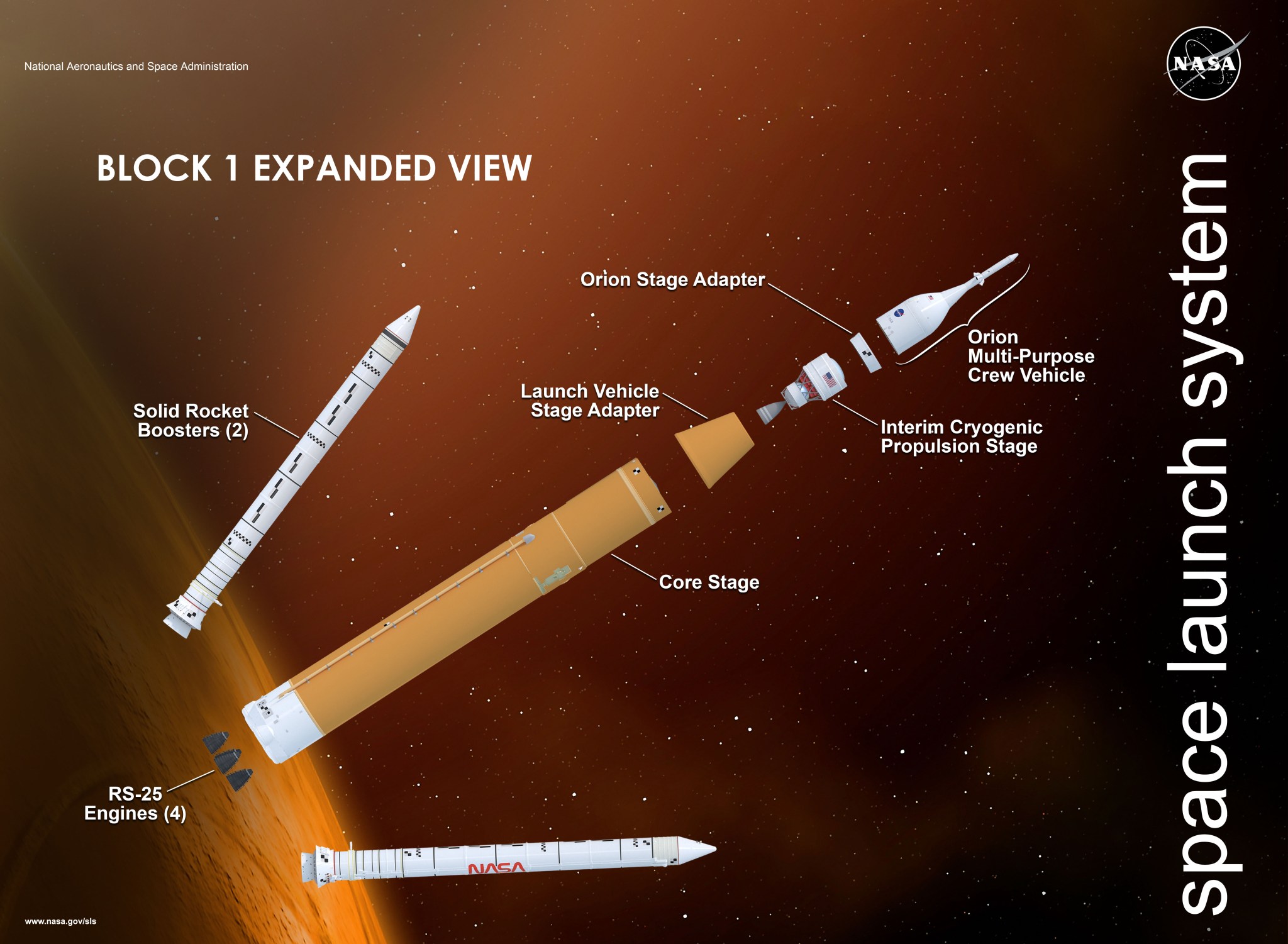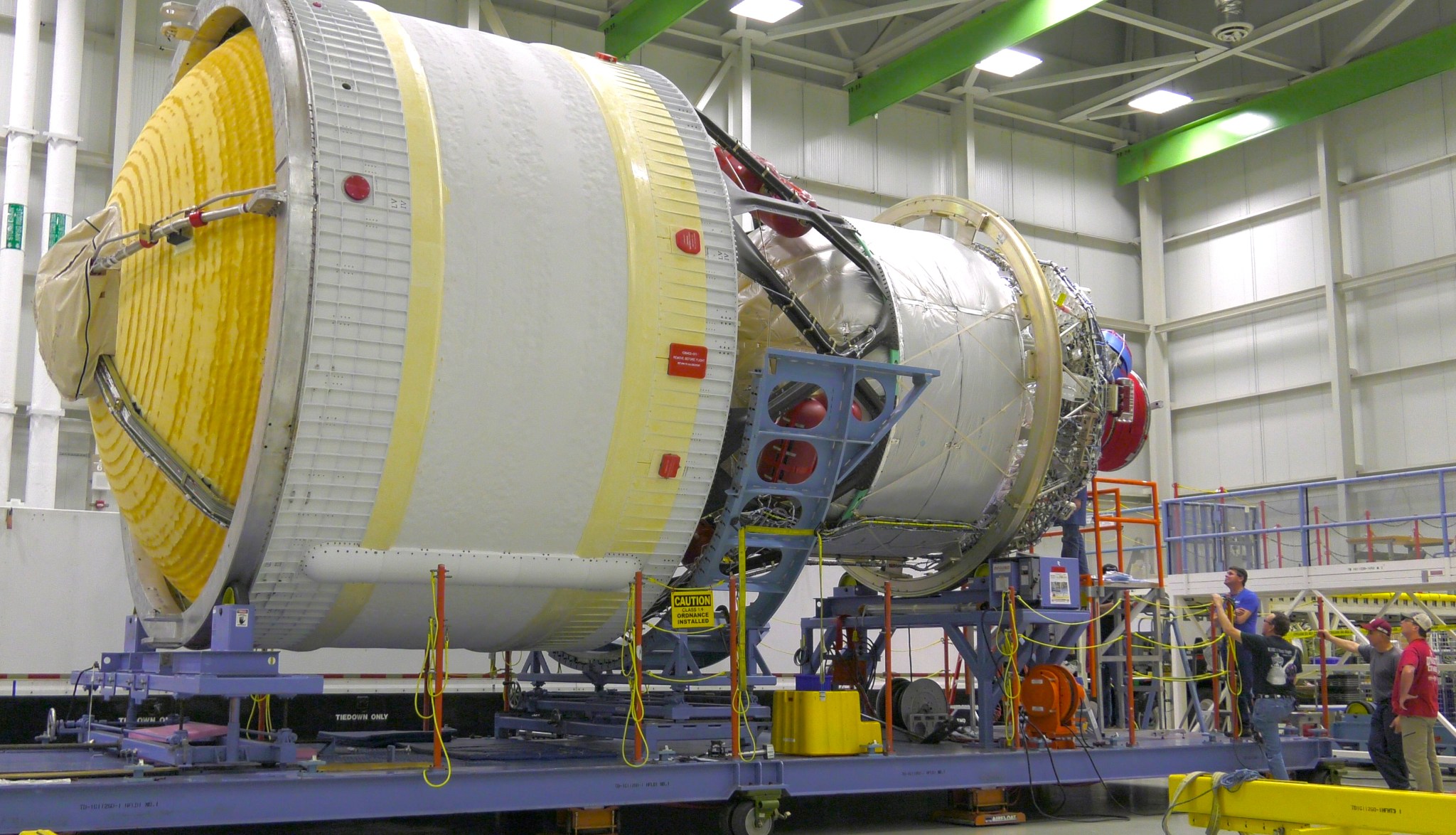The Great Escape: SLS Provides Power for Missions to the Moon
Getting to the Moon requires a powerful rocket ship to accelerate a spacecraft fast enough to overcome the pull of Earth’s gravity and set it on a precise trajectory to its destination. When NASA’s SLS (Space Launch System) deep space rocket, takes off, it will produce a maximum 8.8 million pounds of thrust. Like many rockets, the rocket’s propulsion is delivered in stages.
Liftoff: Core Stage & Boosters
When SLS launched NASA’s Artemis I mission in November 2022, its core stage and twin solid rocket boosters fired to propel the 5.75 million pound rocket off the launch pad at Kennedy Space Center in Florida to send it into orbit, carrying an uncrewed Orion spacecraft. In a mere eight minutes, the mega rocket’s four RS-25 engines burned 735,000 gallons of liquid propellant to create two million pounds of thrust and the twin rocket boosters burn more than two million pounds of solid propellant to create more than seven million pounds of thrust. During ascent, rocket engineers often say the rocket is going uphill, likening this phase of launch to carrying a huge weight up a mountain with Earth’s gravity pushing back the whole time.
After the rocket burns through the fuel in the boosters and core stage, it drops them, much like a hiker might drop a heavy backpack to climb the last few miles to a mountain’s peak. SLS uses its power to maximize the cargo the rocket can send to the Moon. That’s why SLS does not carry extra fuel or propulsion systems necessary to return any stages to Earth for reuse. The solid rocket boosters separate two minutes into the flight, and the core stage falls away around eight minutes after launch.
The Big Move to the Moon: Trans-Lunar Injection
After SLS loses the weight of its first stage propulsion systems and fuel, more power is still needed to send Orion to the Moon. At this point, the upper part of the rocket and Orion are soaring almost 100 miles above Earth, accelerating at more than 17,500 miles per hour, and beginning a circular orbit around Earth. This is low-Earth orbit, often referred to as LEO. SLS in its Block 1 configuration for the first three Artemis missions can deliver more than 95 metric tons (209,439 pounds) to this orbit. However, a deep space mission requires a rocket that can travel beyond LEO with enough power and speed to overcome the pull of Earth’s gravity and send the spacecraft even farther to reach the Moon. The upper part of rocket prepares for the next big move to send Orion out of LEO without even completing a full orbit of Earth.
This big move is called a trans-lunar injection, or TLI, and is the key maneuver that makes it possible to send Orion 280,000 miles beyond Earth and 40,000 miles beyond the Moon. The amount of mass a rocket can send to the Moon is determined by its performance at TLI. The initial configuration of SLS can send more than 27 metric tons (59,000 pounds) to lunar orbits and future upgrades will enable the rocket to send at least 46 metric tons (101,000 pounds).
The TLI maneuvers will differ between Artemis I and II. For Artemis II, the first test flight with astronauts aboard Orion, the ICPS and its single RL10 engine will fire twice to put Orion and its crew into a high-Earth orbit where they will then take Orion for a “test drive” around the ICPS to check out Orion’s manual handling qualities using the ICPS and its auxiliary target before heading to the Moon. Like Artemis I, the TLI maneuver for Artemis III will begin as the upper part of the SLS rocket, officially named the interim cryogenic propulsion stage, fires one RL10 engine producing 24,750 pounds of thrust to accelerate the vehicle to more than 24,500 miles per hour, a velocity fast enough to overcome the pull of Earth’s gravity and propel Orion out of low-Earth orbit to send the spacecraft to the Moon. The TLI maneuver precisely targets a point about the Moon that will guide Orion close enough to be captured by the Moon’s gravity.
What comes next? People Traveling Farther from Earth than Ever Before
NASA’s SLS rocket met or exceeded all performance expectations on its debut flight with Artemis I. As SLS evolves over future missions to unprecedented accommodation of payload mass and volume and unrivaled performance, the rocket will allow NASA to send missions to deep space and reach distant destinations faster than ever before. On its second mission carrying Orion and astronauts, Artemis II, SLS will send Orion and its crew farther than people have traveled before around 250,000 miles from Earth, 10,000 miles beyond the Moon. Like Artemis I, the second flight will use a Block I version of the SLS. On the third flight, Artemis III, SLS will send Orion and astronauts on a mission to land on the Moon. Americans, along with their international and commercial partners, will use the Moon as a proving ground to test technologies and prepare for missions to Mars.
To land larger cargos on the Moon and to send people to Mars, SLS will evolve to a configuration called Block 1B. This rocket configuration will use a powerful exploration upper stage instead of the interim cryogenic propulsion stage and be capable of sending 38 metric tons (84,000 pounds) to the Moon. One feature that will help the rocket haul payload to space along with Orion is the universal stage adapter. It acts like the trunk in a large van and allows SLS to send both astronauts and large cargo that take up more than 10,000 cubic feet and weigh up to 10,000 pounds. Carrying only cargo, the rocket’s 8.4-meter shroud could hold three fully loaded school buses or the equivalent of 30 Mars Curiosity rovers that are about the size of a small car. Large parts of NASA’s Gatewaycan be launched along with the Orion spacecraft or on separate flights.
The ultimate evolution of SLS is the Block 2 rocket that can carry either crew and cargo or just cargo needed for Mars exploration or for planetary missions headed to the outer solar system. The Block 2 launch vehicle reaches orbit with the same core stage used by smaller versions of the rocket, but more powerful boosters will increase thrust to 9.5 million pounds. This will allow it to launch up to more than 46 metric tons (100,000 pounds) to deep space.
Peaceful Exploration for Humanity
SLS is part of NASA’s backbone for deep space exploration, along with Orion and the Gateway in orbit around the Moon, and commercial landing systems. SLS is the only rocket that can send Orion, astronauts, and supplies to the Moon in a single launch. Artemis is a new era of discovery that requires all of humanity, including international and commercial partners, to help make these ventures possible and sustainable. Partners can help provide routine delivery of supplies and equipment needed to live and work on the Moon and in deep space. SLS and Orion are planned to fly once or twice a year and will focus on dependable, safe flights for humans and large cargo.
America and the world are ready for this new era of space exploration. The Apollo Program gave humanity its first experience traveling to a foreign world. NASA’s planetary probes and great observatories have revealed the Universe in all its mystery. One hundred and thirty-five NASA space shuttle missions, 20 years building the International Space Station, the largest structure ever constructed in orbit, and 18 years of continuous human presence in space have helped us learn to live and work in space. Artemis ushers in a new era of human exploration and discovery.



























